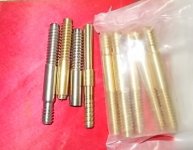[...]
I am new to Hardinge lathes but am going to try the brass tapered collets that were taper machined on a CNC lathe to match my butt and shaft tapers at the size I install my pin and thread my shafts..[...]
It's astonishing to me how you boast of incredible - no make that unbelievable - accuracy when installing your joint pin, and yet naively think you'll get the best result using brass emergency collets machined on a different lathe than the one they're to be used on. The gaps in your knowledge and common sense are truly staggering.
If you want the best accuracy possible you will machine the collets on the same lathe they'll be used on later. Doing that automatically compensates for any runout in the headstock, collet seat, and any number of other characteristics of that lathe. You can't reliably get that kind of repeatable accuracy any other way, and as boastful and know-it-all as you are about... well, about everything, it's kind of telling that you aren't even aware of that simple beginner machinist's trick.
You ought to be embarrassed. Your personality quirks ensure that you aren't, of course... but you ought to be.
TW


